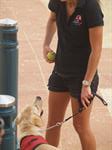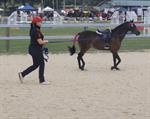 Nowadays we recognise that animals learn in different types of ways. The following table illustrates learning from simpler mechanisms at the top down to more complex types:
Nowadays we recognise that animals learn in different types of ways. The following table illustrates learning from simpler mechanisms at the top down to more complex types:
- Classical Conditioning - Animal learns by associating a stimulus with a response
- Operant Conditioning - Animal learns by positive or negative reinforcement following an action
- Learning Sets - Animal learns through trial and error
- Insight Animal - Animals learn through understanding the relationships between different parts of a problem
- Imitation - Animal learns by watching others and using mental representations to copy them
- Cognitive Mapping - Animal learns by using mental representations of the environment
Instinctive behaviours precede conditioning. Many insects, for example, follow a very set life cycle: a female lays the eggs on a particular plant or prey, the larvae hatch and eat, then go through certain developmental stages, recognise mates by certain signals, perform specific mating behaviours, lay eggs, provide the eggs with suitable nourishment and will most commonly die before the next generation is born. This goes on generation after generation. If the circumstances and environment in which the insect lives stay the same, there is little reason for the animal to change.
Similarly, many aspects of animals behaviour remain fairly fixed. Mammals will move away quickly if they prick themselves on a thorn or if burnt, and they will involuntarily blink if something rapidly approaches their eyes. These are simple reflex responses.
Environment and Learning
 However, animals demonstrate higher level learning in relation to changes in the environment. In fact, the environment is not independent of animal learning. Every animal is constantly interacting with the environment. The environment affects the animal and vice versa. Fixed behaviours are more suited to environments which are stable.
However, animals demonstrate higher level learning in relation to changes in the environment. In fact, the environment is not independent of animal learning. Every animal is constantly interacting with the environment. The environment affects the animal and vice versa. Fixed behaviours are more suited to environments which are stable.
For example, if a mammal knows where to go for food and goes to the same place every time it is hungry, what happens if the food dries up? If the animal continues to go to the same place every time it is hungry, it will die. But if the animal learns that it will have to go to a new location for food, it might have a chance of survival. Think of the complex behaviour of some animals. They will move to different areas at certain times of the year to find food, then return to their original area when the food is replenished. So animals who survive tend to be those who are able to respond positively to changes in their circumstances. Animals can achieve this by using cognitive maps. They are able to learn the layout of their environment.
Some animals may also use memory. They are able to keep track of events that have happened in the past, such as knowing that when the weather goes cold, and therefore when it is best to return to another area where there has been food in the cold season.
How Instincts and Learnt Behaviour are Related
Even many instinctual behaviours, such as those discussed in the last chapter, are not totally devoid from learning. Sometimes behaviours may appear to be innate but they can improve with repetition - which suggests that some learning has taken place. In fact, there are very few innate types of behaviour that don't become modified through experience.
Critical Periods
Critical periods are an example of a condition which involves innate behaviours but also learning. Critical periods are genetically determined time periods in an animal's life where the animal is ready to learn a specific type of behaviour. If the animal receives the correct environmental stimulus during this period it will learn the behaviour. If it does not receive the stimulus the gene will be turned off and it will fail to learn the behaviour - even if it is exposed to the stimulus after the critical period has ended.
Some animals may have just one critical period, others may have several critical periods of learning which affect subsequent behaviour. These mostly occur around the time of birth or within the first few weeks of life. These periods include behaviours such as how an animal bonds with its parents, how it interacts with other animals or people (socialisation), suckling behaviour, learning to call, or recognising parents.
Sensitive Periods
In some instances, there may be an optimal time for learning a behaviour but it is not critical. These are referred to as sensitive periods. During sensitive periods an animal can still learn the behaviour, just not as efficiently.
Genetic Preparedness
Genes also play a role in learning through preparing animals for learning. Genes may determine what types of behaviours an animal will learn. Usually, the type of behaviour that an animal might be prepared to learn will assist with its survival.
 Extract from our ebook: Animal Behaviour written by our psychology and animal science staff -available as a download here
Extract from our ebook: Animal Behaviour written by our psychology and animal science staff -available as a download here